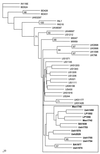Emergence of G9 P[6] human rotaviruses in Argentina: phylogenetic relationships among G9 strains
- PMID: 11682524
- PMCID: PMC88481
- DOI: 10.1128/JCM.39.11.4020-4025.2001
Emergence of G9 P[6] human rotaviruses in Argentina: phylogenetic relationships among G9 strains
Abstract
Because rotavirus diarrhea can be reduced through vaccination and because current vaccine candidates provide protection against only the most common G antigenic types (G1 to G4), detection of uncommon G types is one of the main goals of rotavirus surveillance. After a 2-year nationwide rotavirus surveillance study in Argentina concluded, surveillance was continued and an increase of G9 prevalence in several Argentine cities was detected. During this period G9 strains predominated in the south, and a gradient of decreasing G9 prevalence was observed from south to north (41 to 0%). Sequence analysis of gene 9, encoding the G antigen, showed that Argentine strains cluster with most G9 isolates from other countries, showing less than 2% nucleotide divergence among them, but are distinctive from them in that they present some unique amino acid changes. Our results agree with reports of increased G9 prevalence in other parts of the world, suggesting the need to incorporate G9 into candidate rotavirus vaccines.
Figures


References
-
- Bernstein D I, Sack D A, Rothstein E, Reisinger K, Smith V E, O'Sullivan D, Spriggs D R, Ward R L. Efficacy of live, attenuated, human rotavirus vaccine 89-12 in infants: a randomised placebo-controlled trial. Lancet. 1999;354:287–290. - PubMed
-
- Bishop R F. Development of candidate rotavirus vaccines. Vaccine. 1993;11:247–254. - PubMed
-
- Bok K, Castagnaro N, Borsa A, Nates S, Espul C, Fay O, Fabri A, Grinstein S, Miceli I, Matson D, Gomez J. Surveillance for rotavirus in Argentina. J Med Virol. 2001;65:190–198. - PubMed
-
- Bok K, Castagnaro N C, Diaz N E, Borsa A, Cagnoli M R, Nates S, Yudowsky S, Espul C, Cuello H, Fay O, Brunet B, Ues O C, Santoro R, Grinstein S, Gonzalez F, Miceli I, Gomez J A. [Rotavirus laboratory network: results after one year of observation] Rev Argent Microbiol. 1999;31:1–12. . (In Spanish.) - PubMed
Publication types
MeSH terms
Substances
Associated data
- Actions
- Actions
- Actions
- Actions
- Actions
- Actions
- Actions
- Actions
- Actions
- Actions
- Actions
- Actions
- Actions
LinkOut - more resources
Full Text Sources
Medical

